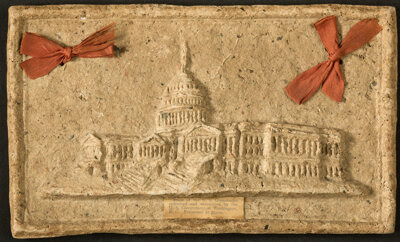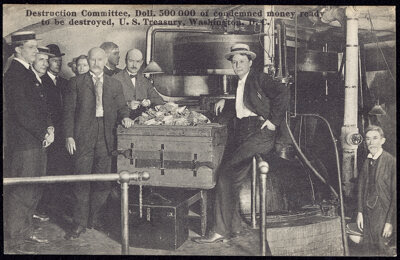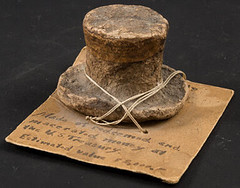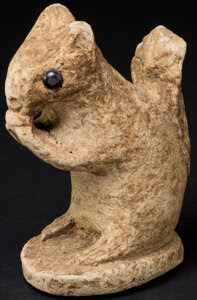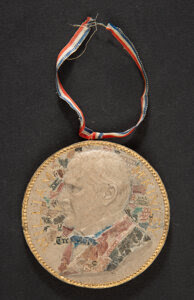
PREV ARTICLE
NEXT ARTICLE
FULL ISSUE
PREV FULL ISSUE
THE CAPITAL COLLECTION OF MACERATED CURRENCYThe September 1, 2021 issue of the Heritage Currency News email discussed the firm's upcoming sale of the Capital Collection of macerated currency. -Editor Heritage has been honored to auction many impressive collections of well-known numismatists over the years, but few are both as unusual and impressive as The Capital Collection of Macerated Currency. This offering showcases the combined macerated collections of Heritage's own Len Glazer and of the estate of well-regarded Rhode Island numismatist Wade Boughton. A Brief History of Macerated Currency Collectibles Government-backed paper currency in the United States came into general use right at the beginning of the Civil War in the spring and summer of 1861. After several years of heavy usage, it became apparent that the Treasury Department needed a method of destroying old paper money that was no longer fit for circulation. Initially, the old notes were burned in a special furnace located in a vacant lot behind the White House that was called the "White Lot." Because the bills needed to be traced, counted and carefully transported, they were sorted and bundled before burning. Burning bundles of notes completely, proved to be nearly impossible, and large partially burned pieces escaped through the chimney. It didn't take long for a small army of individuals to start scouring the lot for large fragments that were big enough to redeem at the Treasury as accidently burnt. Moving at normal governmental speed, it took until 1874 to develop a better method for destroying old bills. That method was called maceration, where a large machine in the sub-basement of the Treasury would thoroughly grind up the paper money while wet turning it into pulp. Tourists were permitted to watch the process, and it became a highlight for visitors to Washington. At first the pulp was simply dumped until some individual, long lost to history, hit upon the idea of reforming the pulp into small souvenirs. By 1875 these souvenirs were being sold to the general public through shops. The souvenirs caught on, and by the turn of the century there were over thirty "Remembrance Shops," "Souvenir Stores" and street side "Memento Stands" in the areas of Washington D.C. most heavily traveled by tourists. Among the most popular and numerous items were Uncle Sam style hats, ladies' shoes, pitchers, Washington Monuments, postcards, animals, buildings and busts of famous people. Most were in the two-to-six-inch range. There were dozens of manufactures, some identified by labels on the bottom of the souvenirs, and many of them anonymous. Using the joint collection being offered here, a list was compiled of known producers. Some of these are very rare, and others quite common. Over 90% of all labels make no mention of the producer. Many of the macerated souvenirs had labels stating something along the lines of, "Made of $2000 (or $3000, or $5000, etc.) in U.S. Currency Destroyed by the Treasury Department." Of the labels that we have been able to identify, the most common was the National Currency Souvenir Company located at 1238 New Jersey Avenue NW. Entrepreneur and sculptor W.H. Abbott produced many of the best National Currency Souvenir Company's pieces. He seems to have gone into and out of their employ several times between 1880 and 1910. During his independent periods, he produced macerated under his own name. One label gives an address only with no name; they were located at 807 18th Street, Washington D.C. Another relatively common producer was O. Duke. He was located at 715 14th Street NW. Duke's labels appear three ways: name only, address only and both. H. Martin was a producer, but his address is unknown. J.F. Jarvis produced entirely postcards from his 135 Pennsylvania Ave. Washington, D.C. address. The U.S. Souvenir Company, located at 705 H. Street NW, was a knockoff organization that used a similar name and nearly identical pieces to the much larger and better-known National Currency Souvenir Company. Charles Snyder, at 742 6th Street NW, was a very rare manufacturer, and at the very end of the period, Henri Stewart produced some modern (late 1920s) macerated and a point of purchase display to help sales. Stewart was located at 347 5th Ave., New York, and is the only manufacturer we know of outside of Washington D.C. His point of purchase display was copyrighted in 1927. Initially, visible pieces of currency could be seen in the souvenirs, but in 1908 chemicals were added to the new macerating machine to turn the notes into a gooey gray pulp with no traces of ink or paper pieces. The business of producing macerated souvenirs continued, but without identifiable pieces of currency visible, the public lost interest. Several producers added snipped pieces of currency to the post-1908 pulp to simulate earlier pieces. Some of those pieces were simply dumped in; in a few rare examples they were actually placed to accent the design. Some pieces of macerated were still produced into the late 1920s, but that seems to have been the end. Pre- and post-1908 pieces are easily distinguishable by the presence or lack of currency bits. Collecting of macerated seems to have started late. There do not seem to be any meaningful collections formed prior to the 1960's. Notable collections have been formed by Ruth Bauer, Harmer Cole, and more recently, Tom Durkin, Bert Cohen, Art Leister, Wade Boughton, and Len Glazer. Raiden Honaker's Macerated Currency Interview with Len Glazer Consignment Director, Raiden Honaker visited with Len Glazer briefly to talk about the hobby and gain some insight into the treasures that he and Wade both so enjoyed collecting. When or how did you start collecting Macerated Currency?
What is the time frame that Macerated Currency was created? 1874 would be the earliest that Macerated Currency could have been created, as before then currency was simply burned. The latest would be the early 1930s, as we know because examples of FDR and Lindbergh's Spirit of St. Louis were created. The time frame of 1885 to 1915 was the heyday of Macerated Currency. Can or have you ever identified pieces of US paper currency used in the items? Are there ever pieces large enough to distinguish which note it is? Absolutely, Nationals, mainly 1882 Brownbacks are the most common. If you use a magnifying glass, you can identify pieces, most commonly $5, $10, and $20 Brownbacks in the Macerated Currency. I love it, it's fun to try and identify pieces and imagine which notes the macerated currency examples are made from.
The rarest of the collectible items would have to be the large squirrel from Wade's collection, the two different posed rabbits, and the cross that I acquired. The cross is the only religious artifact from Macerated Currency, which makes for an interesting subject. The three cats posed on top of the capitol building is likely unique as well. Are there pieces that were confirmed to have been created, but never discovered? There are no listings or official records of what was made or how many of each example was created, so it is quite difficult to know and track what there was. When the squirrel turned up it was the first one anybody saw, the same goes for the "DIY" Macerated block. So, there may be more to surface over the course of time. There may be pieces out there that we are currently unaware of that will be "discoveries" upon their surface. Are there any pieces that you or Wade were never able to locate?
Do you have a favorite example out of all of the collection? The William McKinley (LOT ID# 11008) would have to be among my favorite pieces, as it is considered modern, from the 1920s. The capitol building with the flag on top and drapes on the side has always stood out to me, even though it's a bit more common. The cross and bunny pieces are also among my favorites. There are several items depicting US Presidents such as Teddy Roosevelt, Calvin Coolidge, and William McKinley (ID 11045, 11053, 11066). Do you know if any of these Presidents owned or had any interest in Macerated Currency? No, I have never seen any pictures of historical figures with Macerated Currency. You have Truman who had his coin collection and JFK with his Swedish copper plate money, but never a US President with macerated currency. There was ever any mention of it with regard to any historical figures. Macerated was not very popular up until the 1940s. Any advice or words to the new generation of collectors about collecting Macerated Currency? Don't buy by price, buy by scarcity. Buy the unusual examples rather than accumulating common pieces such as shoes and hats. This is an exciting auction as there has never truly ever been a great Macerated Currency auction up until now.
Wayne Homren, Editor The Numismatic Bibliomania Society is a non-profit organization promoting numismatic literature. See our web site at coinbooks.org. To submit items for publication in The E-Sylum, write to the Editor at this address: whomren@gmail.com To subscribe go to: https://my.binhost.com/lists/listinfo/esylum All Rights Reserved. NBS Home Page Contact the NBS webmaster 
|
